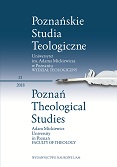Diecezja poznańska u schyłku Rzeczypospolitej Obojga Narodów
The Poznań Diocese at the Decline of the Polish-Lithuanian Commonwealth
Author(s): Piotr Franciszek NeumannSubject(s): Christian Theology and Religion, History of Church(es), 18th Century
Published by: Uniwersytet Adama Mickiewicza
Keywords: Poznań diocese;Poznań bishop;Andrew Stanislaus Kostka Młodziejowski;Anthony Onuphrius Okęcki;Poznań catedral;Poznań chapter;collegiate churches;archdeaconships;deaconships;parishes;religious orders;
Summary/Abstract: In the investigated period of the years 1768–1793, the Poznań diocese belonged to the Gniezno metropolitan area and comprised the territory of more than 28 000 square kilometers, divided into two parts - Great Poland and Masovia. Poznań bishops resided mainly in Warsaw, in the Masovian part. The diocesan office in the years 1768–1780 was held by Andrew Stanislaus Młodziejowski and in the years 1780–1793 by Anthony Onuphrius Okęcki, both involved in state issues, including the post of crown chancellors. Pontifical duties were performer mainly by bishops suffragan, while the diocese was managed by general curates. The cathedral chapter in Poznań, constituted by 10 prelates and 23 canons, was the elite of the clergy. In addition to that, there were other bodies of clergy like curates, penitentiaries, two missionary colleges, rorantists and altarists. Collegiate chapters existed in three churches in Poznań, as well as in Warsaw, Środa Wielkopolska (Great Poland), Szamotuły and Czarnków. The area of the diocese was divided in to four archdeaconships - Poznań, Śrem, Pszczew and Warsaw - each divided into deaconships, amounting to the number of twenty nine. Within the territory of the diocese there were 466 parish churches and a significant number of churches and chapels of various character, with an abundance of priests. The clergymen derived mainly from the townspeople, and delegates of the bishop visiting the parishes positively assessed their moral conduct. In 1772 there were 78 male monasteries with 1549 monks and 17 female monasteries in the whole diocese.
Journal: Poznańskie Studia Teologiczne
- Issue Year: 33/2018
- Issue No: 1
- Page Range: 163-175
- Page Count: 13
- Language: Polish

